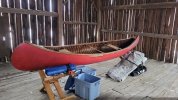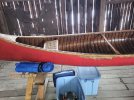Hi Kevin, Andre's suggestion of using golf tees is a good one. I've often wasted time in whittling something to fit. I've often used a two part epoxy wood filler which has also been helpful but only where it wouldn't be seen as it's hard to blend into existing wood. I've included a picture of this product below. I'm not sure if it's available in the States though?
Yes it is a good idea to fill any old holes and cracks in the rib ends as you'll be screwing the inwales into them and then the outwales through the planking, specially if you are replacing these and wont be re-using the old holes.
I like to place the screws for my inwales on the bow side of the rib, then when I'm putting the outwales on I know to position these screws on the stern side of the ribs so both slightly off center, thus eliminating the problem of drilling and hitting an existing screw.
Gary
View attachment 54884




